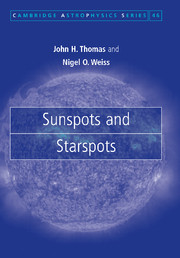Book contents
- Frontmatter
- Contents
- Preface
- 1 The Sun among the stars
- 2 Sunspots and starspots: a historical introduction
- 3 Overall structure of a sunspot
- 4 Fine structure of the umbra
- 5 Fine structure of the penumbra
- 6 Oscillations in sunspots
- 7 Sunspots and active regions
- 8 Magnetic activity in stars
- 9 Starspots
- 10 Solar and stellar activity cycles
- 11 Solar and stellar dynamos
- 12 Solar activity, space weather and climate change
- 13 The way ahead
- Appendix 1 Observing techniques for sunspots
- Appendix 2 Essentials of magnetohydrodynamic theory
- References
- Index
7 - Sunspots and active regions
Published online by Cambridge University Press: 28 October 2009
- Frontmatter
- Contents
- Preface
- 1 The Sun among the stars
- 2 Sunspots and starspots: a historical introduction
- 3 Overall structure of a sunspot
- 4 Fine structure of the umbra
- 5 Fine structure of the penumbra
- 6 Oscillations in sunspots
- 7 Sunspots and active regions
- 8 Magnetic activity in stars
- 9 Starspots
- 10 Solar and stellar activity cycles
- 11 Solar and stellar dynamos
- 12 Solar activity, space weather and climate change
- 13 The way ahead
- Appendix 1 Observing techniques for sunspots
- Appendix 2 Essentials of magnetohydrodynamic theory
- References
- Index
Summary
Sunspots are the most conspicuous but not the only product of solar magnetic activity. In this chapter we relate sunspots to other manifestations of solar activity, such as the emergence of magnetic flux at the solar surface, the formation of active regions, and the organization of magnetic flux into small flux tubes, pores and sunspots. We also consider the evolution of an individual sunspot, from its formation by the coalescence of small magnetic flux tubes and pores to its decay through the loss of magnetic flux at the periphery. Most of this chapter is devoted to features seen in and immediately above the photosphere, but we also attempt to relate these features to processes occurring beneath the solar surface.
Description of active regions
Magnetic activity on the Sun is not uniformly distributed over the solar surface, but instead is concentrated into active regions where sunspots, pores, faculae, plages and filaments are gathered. The underlying cause of all these features of solar activity is the Sun's magnetic field; an active region is basically a portion of the solar surface through which a significant amount of magnetic flux has emerged from the interior. Magnetic fields are also found everywhere on the solar surface outside of active regions, in weaker, more diffuse form or as small flux concentrations in the intergranular lanes, but those fields are not organized into the structures that so clearly define an active region. Active regions can be easily identified in full-disc magnetograms, such as the one shown in Figure 7.1.
- Type
- Chapter
- Information
- Sunspots and Starspots , pp. 123 - 149Publisher: Cambridge University PressPrint publication year: 2008

